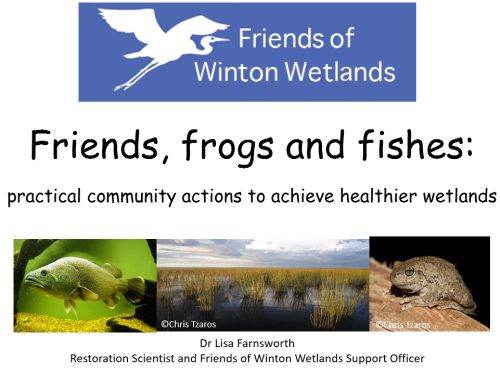Threatened Species Initiative case studies - 27 April 2017
SWIFFT video conference notes are a summary of the video conference and not intended to be a definitive record of presentations made and issues discussed.
This video conference was supported through resources and technology provided by the Department of Environment, Land, Water and Planning, Victoria. SWIFFT wishes to thank speakers for their time and delivery of presentations. Thanks to Michelle Butler who chaired the session from Ballarat.
The second video conference for 2017 had a theme: Victorian Threatened Species Protection Initiative - case studies
KEY POINTS SUMMARY (Quick take home messages from this video conference or read through the speaker summaries)
- What have we done with $6m in the Threatened Species Protection Initiative program?
- Managing Crown Land Reserves – Ballarat Environment Network (BEN)
- Abundance and Distribution of Southern Right Whale in SE Australia
- Friends, frogs and fishes - practical on ground community actions to achieve healthier wetlands
- Mt Korong Eco-Watch "Rewilding Korong Ridge": Three Threatened Species Projects
- Protecting Victoria’s Biodiversity – Biodiversity 2037
A total of 88 participants were connected across 16 locations; Ararat, Ballarat, Benalla, Bendigo, Colac, Geelong, Hamilton, Heywood, Horsham, Heidelberg (Arthur Rylah Institute), Knoxfield, Nicholson Street - Melbourne, Orbost, Traralgon, Warrnambool and Wodonga.
List of groups/organisations in attendance
Educational: Federation University, Gordon TAFE.
Local Government: Colac Otway Shire,
Field Naturalist Clubs: Ballarat, Bendigo, Hamilton, Portland, Geelong and Bairnsdale.
Community Conservation Groups: Ballarat Environment Network, Friends of Eastern Otways, Garibaldi Landcare, Napoleons Landcare, North Bendigo Landcare, Mt Korong Eco-Watch, Wombat Forestcare, Kara Kara Conservation Management Network, Friends of Brisbane Ranges, Moorabool Landcare, Torquay Landcare, Victorian Volcanic Plains CMN, Friends of Bannockburn Reserve.
Conservation Organisations: Parks Victoria, Department of Economic Development, Jobs, Transport and Resources (Hamilton), Department of Environment, Land, Water and Planning (DEWLP) staff across 16 locations, inc. Nicholson Street, Knoxfield and Arthur Rylah Institute, Heidelberg.
Private individuals: x 2
SPEAKER SUMMARIES
What have we done with $6m in the Threatened Species Protection Initiative program? - Michelle Butler - DELWP
Michell spoke about the tremendous efforts undertaken by groups in working on threatened species conservation projects. The Threatened Species Protection Initiative funding comprised;
- critical actions and strategic partnerships
- community volunteer action grants
- threatened species collection


Michelle spoke about the Threatened Species Collection which involved groups undertaking on-line fund raising matched by DELWP if their target was reached. There were 5 successful campaigns which raised money so groups could undertake their threatened species projects.

Other projects undertaken within the initiative included;
- 45 Bayesian models (improved understanding of species distribution and ecology)
- Environmental economic accounts
- Monitoring framework
- Threatened Species Protection Initiative Seminar, September 2016
- Evaluation
Biodiversity on-ground action
Michelle spoke about new funding that will focus on protecting and managing a range of native plants and animals, threatened species and habitats through increased engagement and alignment of natural resources, scientific, educational and community sectors.
More details: Biodiversity on-ground action
The funding for 2017 includes Threatened species projects and Community & Volunteer Action Grants (application closing date 10 May 2017).
Icon species
Michelle spoke about $2 million specific funding to support intensive management actions relating to the following species;
- Baw Baw Frog
- Brush-tailed Rock Wallaby
- Eastern Barred Bandicoot (mainland subspecies)
- Helmeted Honeyeater
- Leadbeater’s Possum (lowland population)
- Mountain Pygmy Possum
- Orange-bellied Parrot
- Hooded Plover
- Regent Honeyeater
- Plains-wanderer
Additional activities
- Emergency Response Framework
- Adaptive Learning
- Regional Biodiversity Hubs Regional hub projects involve agencies and organisations working together in large –scale projects to address threats to a range of important native species in priority areas across the state.
- Seminars
- Crowdfunding
Contact: Michelle Butler, via DELWP Customer Service Centre 136186
Managing Crown Land Reserves – Ballarat Environment Network (BEN) – Ray Draper
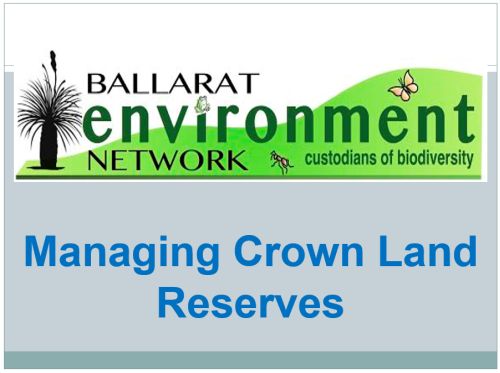
Ray provided an overview of Ballarat Environment Network (BEN) which was formed in 1992 by bringing many groups together to be able to talk with one voice for the conservation of native vegetation and the dependant fauna.
In 2002, 23 uncommitted Crown Land blocks were assessed by BEN for their biodiversity values to determine if BEN would take on their management or not as Crown Land was being actively sold off at that time.
A quick assessment guide was developed which came up with a score for of the reserves. Significant biodiversity values were found on many of the parcels assessed and there was a concern that these values would be lost or compromised by sale or subdivision.
Initially the Ballarat Environment Network took on Committee of Management for seven reserves. Ray said BEN are now Committee of Management for 51 reserves and counting.
On-ground management
Ray spoke about the massive weed problems which existed on most of the reserves. Weed control has been targeted over the years. Now weeds are mostly gone or under control.
Other on-ground management between 2003 to 2017 has included:
- building fences.
- installation of interpretive signs at some reserves.
- conducting ecological burns.
- planting seedlings.
- conducting flora surveys.
- monitoring and recording everything done on the ground.
- Extensive monitoring has resulted in an extensive data bank which is still being extended.
Monitoring
Ray spoke about the extensive collection of data on the distribution of plant species and the ground-truthing of Ecological Vegetation Classes (EVCs). BEN also collected site specific background information;
- Site description
- Site history
- Flora and fauna records
- Geology
- EVC information
The collection of as much data as possible in the reserves combined with implementation records helps build a picture to enable management of the reserves. Ray said the approach taken so far is in line with recent scientific thinking around ecological restoration which uses an adaptive management framework.
In some instances, the data collection and can uncover an insight into the poor public perception of the value of reserves or biodiversity in general. Ray highlighted the comment by one person that it is criminal to not have cattle on the Corindhap Reservoir reserve.
Ray spoke about some of the reserves BEN manages and their biodiversity values.
Judds Road Reserve - Yellow-footed Antechinus (Antechinus flavipes).
Haddon Wetland – breeding area for brolga and growling grass frog.
Mullawallah Wetland (formerly Winter Swamp) – 85 bird species (48 wetland species) also supports Growling Grass Frogs and Brolgas. Plantings involved the reinstatement of the original ground flora (Common Tussock-grass and Sedges) as well as scattered trees (Swamp Gums) and shrubs.
Nintingbool Water Reserve – Yarra Pygmy perch and Bribron’s Toadlet.
Newtown Cricket Reserve - transition from Plains Grassy Woodland to Heathy Dry Forest.
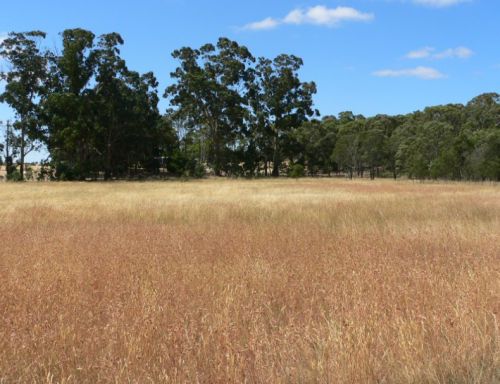
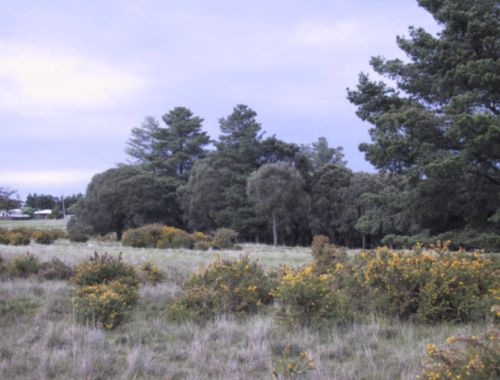


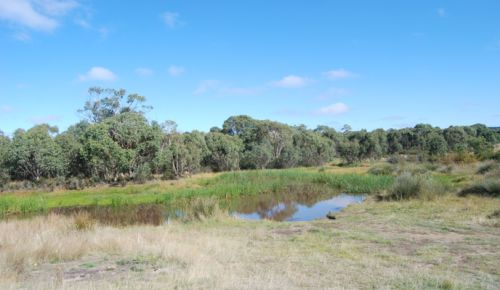
Results
All 51 reserves that BEN now manage are in excellent condition compared to when they were first acquired as reserves with Gorse, Blackberry, Hawthorn, Thistles etc., plus Rabbits and Foxes in most of them.
Ray said there are still weed problems such as Gorse but with ongoing management these are slowly diminishing.
Some of the reserves contain low levels of biodiversity values but are used to derive an income source from mobile towers and sugar gum revenues to support BEN’s administration officer and reserve manager.
Ray felt that with the current loss of native vegetation across Victoria it makes the BEN reserves extremely important, to protect them for their biodiversity values.
Ray thanked the local volunteers who help look after some of the reserves, this type of support is invaluable.
Abundance and Distribution of Southern Right Whale in SE Australia - Mandy Watson, Senior Biodiversity Officer, DELWP.
Threatened Species Initiative funding has allowed the collation of a significant amount of data relating to Southern Right Whales which has been collected since the 1980’s in Victoria.
Background about the species
Mandy provided some backgrounf about the Southern Right Whale, so named by early whalers because it was the ‘right whale’ to hunt. They are a large whale yielding a lot of oil and approach close to shore. They also float when killed which made them a favourable species to hunt.
In the first half of the 19th Century, Right Whales were heavily exploited with an estimated 150,000 killed globally. Population estimates of the Southern Right Whale Eubalaena australis are about 12,000 across the whole Southern Ocean with the Australian population now estimated to be 3,500.
Mandy spoke about the fact that only a few calving grounds exist in Australia with most of the aggregation areas west of ‘the head of bite’ with only a few sites in south-eastern Australia and only one known breeding site located at Warrnambool.
Current conservation status
- Listed as Endangered under the Commonwealth Environment Protection and Biodiversity Conservation (EPBC) Act 1999
- Listed under FFG Act
- Considered Critically endangered (Victorian Advisory List)
Recovery
Mandy said when people think about recovery they often think about how successful the recovery of Humpback Whales has been but do not realise recovery of Southern Right Whales is much slower in Australian waters, particularly in south-eastern Australia where there has been no evidence of recovery. Information from aerial surveys and population modelling indicate the population in SE Australia could be 250 – 300.
Genetics
Results from studies involving samples taken from Vic, WA and NZ calving grounds and migratory corridors in SA, TAS, NSW and QLD has found there is a genetic difference between the south-east population of Southern Right Whales and those in the west of Australia. The studies also found whales from different calving grounds mix on migratory corridors.
Threats
Mandy provided an overview of current threats
- Vessel strike
- Entanglement
- Noise Interference (mainly from seismic surveys)
- Habitat Modification (boating activity, commercial & recreational fishing)
- Climate change (more studies required)
- Overharvesting of prey (studies underway)
- Whaling (not for Southern Right Whale) but Right Whales generally.
2016 Threatened Species Initiative project
The aims of the project were to collate, analyse and publish current photo identification, sightings, stranding and entanglements data for SRW in Victoria to assess the relative impact of a range of threats.
Two main data sets were used;
- DELWP Southern Right Whale sightings database which contains over 30 years of records.
- South East Australian Southern Right Whale Photo-Identification Catalogue (SEA SRW PIC) which contains and 350 individual whales in 1500 pictures from SA, Vic, NSW, Tas.).
Results of data analysis carried out by ARI.
- Population estimate for SRW using SE Australia was 300 in 2012.
- There was an Increase in SRW population using the South-east Australian coastline from 1993 to 2011 (mainly attributed to whales passing through to southern WA breeding grounds).
- No change in sightings of cow & calf pairs in SW Victoria from 1985 to 2016.
Logan’s Beach
- 12 individual females have calved more than once at Logan’s Beach.
- 85 calves have been recorded at Logan’s Beach since 1980.
- 40 calves born to identified females.
- Average 2.4 calves/year.
- No significant increase in abundance of cow&calf pairs using Logan’s beach from 1993 to 2011.

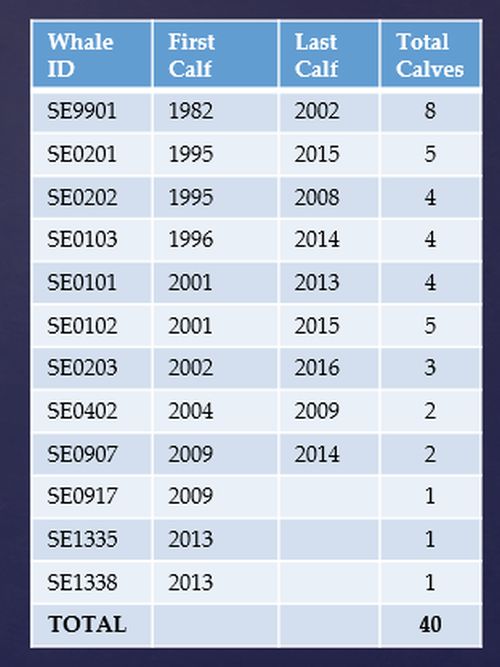
Photo ID matching
This work involved cross matching the SE Australian PIC catalogue with a National catalogue.
- 25 matches were detected (11% of all the whales compared).
- 18 between-season movements of up to 3,800 km were detected (sited at Sydney one year and Israelite Bay, WA another year)
- 7 within-season movements up to 1600 km (the largest between Cape Nelson & Head of Bight)
- Evidence of re-selection by breeding females (only one) to different calving location at Head of Bight (see 'Wilma' below).
- Directional movements support the counter-clockwise migration theory.
- Consistent with genetic studies findings i.e. that mixing of mainly non-calving individuals is occurring in the migratory corridors.
- Stronger structuring on breeding grounds occurring in the calving females.
The Southern Right Whale named 'Wilma'

One of the most well-known Southern Right Whale’s is named Wilma. She was a regular visitor to Logan’s Beach and calved in 1985, '88, ‘90, ‘93, ‘96, ‘97, ‘99, ’02. She was last seen at Warrnambool in 2002. In 2005 she was discovered using a new calving location at 'Head of Bite' where she has since been recorded every three years with a calf. Females have a very strong affinity with their calving location and return every three years to calve. The reason for establishing a new location is unknown but very unusual behaviour.
Conclusions
Mandy explained modelling indicates the South Eastern population of Southern Right Whales faces significant threats. Any observed small population increase is driven by an increase in South Western Australia. There has been no increase in the numbers of cow & calf pairs in South Eastern waters.
Managing the Southern Right Whale as a single population is risky because recent genetic data indicates there are two distinct populations (South Eeastern Australia & South Western Australia.) Whales in South Eastern waters are at a higher risk levels due to a higher human population and associated threats.
Further research required
- Where are the calves going?
- What is the impact of re-selection?
Contact Mandy Watson, Senior Biodiversity Officer | Barwon South West - 03 5561 9961
Key points from questions
- Southern Right Whales undertake annual migration from feeding grounds in southern Antarctic waters to waters of southern Australia for mating and calving.
- More study is required to understand their movement because individual whales are only observed here once every three years. Where they go in other years is unknown. There is a SRW catalogues are maintained in South Africa, South America and New Zealand.
- There is a lot of genetic similarity between SRW’s in south-east Australia and New Zealand.
- Southern Right Whales live for at least 80 years. It is possible that because twhale numbers were so depleted by whaling the memory of calving locations could have been lost in the population.
Friends, frogs and fishes - practical on ground community actions to achieve healthier wetlands - Dr Lisa Farnsworth, Friends of Winton Wetlands Support Officer and Winton Wetlands Committee of Management
About the Winton Wetlands
The Winton Wetlands (formerly known as Lake Makoan) are located in North East Victoria and cover an area of 8,750 ha comprising about half ephemeral wetlands and half red gum box grassy woodland. These habitats support a very rich diversity of biodiversity.
The current project is the largest wetland restoration project in the Southern Hemisphere. The Winton Wetlands Committee of Management took over management of the wetlands in 2010. The Friends of Winton Wetlands was established in 2013 and currently has 60 members. The Friends group undertakes a variety of projects and activities that address the restoration of the wetlands (guided by the Winton Wetlands Committee of Management) and promote them within the local and broader community.
Friends, Frogs and Fishes project
Lisa explained this project was made possible through $11,200 of funding via the Community Volunteer Action Grant, through DELWP’s Threatened Species Protection Initiative.
Objective: To encourage the participation of the community in practical and achievable activities that will enhance wetland habitat for fauna (particularly frogs and fishes) and flora at Winton Wetlands.
Activities 2016:
- Water quality improvement and monitoring
- Wetland habitat enhancement
- Increased knowledge of species requirements and their distribution/presence on the reserve to the general public and users of the reserve.
Great Makoan Carp muster – a community event aimed at removing carp from old borrow pit ponds along the edge of the wetland.
‘Zap and Tap’ Electrofishing Demonstration – showing the community others ways of removing carp and also educational activities to learn about native fish in the area.
Water quality monitoring - this is an on-going voluntary program at 11 sites in the wetlands. Results are provided to Goulburn Broken Waterwatch database and the Committee of Management.
Promotional items - mugs to help raise awareness about water quality and the group.
Habitat enhancement – revegetation of fringing areas of ponds by planting wetland species. Direct seeding of red gum across 9 different locations (about 6.3 million seeds). The group has noticed good regeneration rates from this work.

‘Hop Along’ Frog Discovery Seminar – a community education event to raise awareness about frogs in the area.
Frog recording program – frog calls recorded at 11 sites using a digital sound recorder (Olympus LS-14) for one night/month from June-November 2016. 100’s of hours of frog calls were recorded. The recording captured the change in call frequency before/after significant rainfall event. The group is working with Dr Geoff Heard regarding analysis of calls. Remote acoustic recorders are extremely useful covert way to monitor frog and bird species. Frog call data relatively easy to collect, but very time consuming to analyse.
‘It’s a bugs life’ Waterbug seminar – this was a community education event to emphasise how waterbugs are important to wetland ecology.
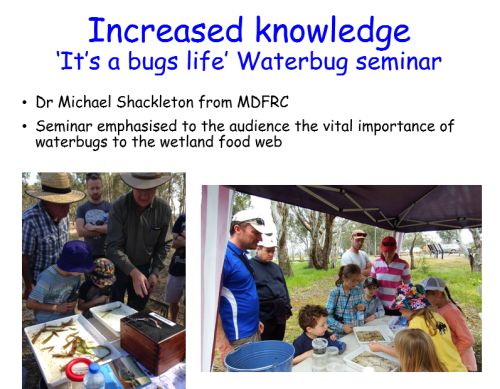

Lisa thanked the supporters of the project which has enabled the community to become involved in restoration of the wetland. She also thanked the Friends group for their efforts.
Key points from questions
- The VNPA Nature Watch program in collaboration with Museum Victoria is also involved with remote recoding technologies combined with software to automatically process recorded data.
- The Friends of Winton Wetlands will work alongside the Regent Honeyeater project group in revegetation projects in the reserve.
Mt Korong Eco-Watch "Rewilding Korong Ridge": Three Threatened Species Projects
- James Nelsson, - Short Story Planting project
- Kate Lee - Short Story Nursery project
- Trudy Nelsson - Pest Species Eradication
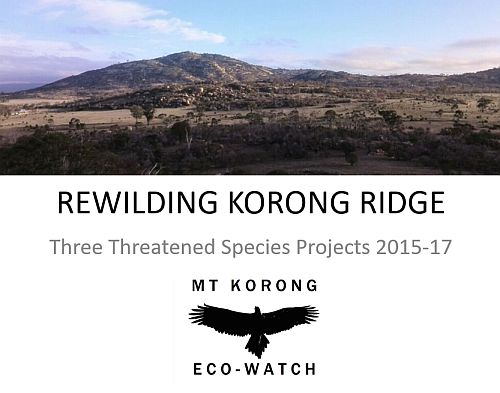
James provided some background information regarding the group and Mt Korong which is a granitic upthrust between Inglewood and Wedderburn in North Central Victoria surrounded by cropping and sheep grazing country with isolated Box-ironbark remnants.
Mt Korong is within a Nature Conservation Reserve managed by Parks Victoria. Adjoining Mt Korong is the 1000 hectare, Korong ridge conservation estate made up of 8 privately owned properties most of which have Trust for Nature Covenants.
James spoke about the significant biodiversity values with 48 listed threatened species and communities located within 5 kilometres of Mt Korong.

The predominant EVC of Mt Korong itself, and surrounding granite foothills is Hills Herb-rich Woodland, where significant populations of threatened and vulnerable species are found, such as Snowy mint bush, Deane’s Wattle, Robust Greenhood, as well as Diamond Firetail, Brown Treecreeper, Hooded Robin and Painted Honeyeater.
Revegetation
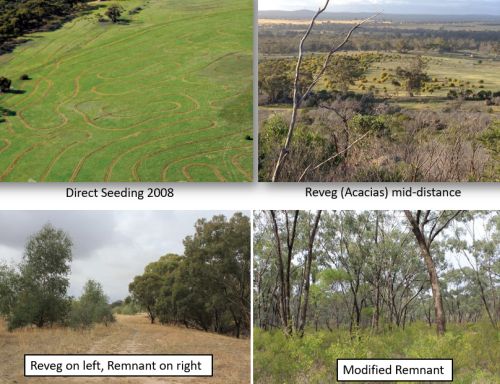
The group wanted to gradually improve habitat by restoring understory species. They first decided to try to restore understory herbs and shrubs to some of the direct-seeded areas and to remnant areas that were still depauperate after 10 years without sheep.
Rewilding Korong Ridge
In 2016, the group received Threatened Species Initiative funding to undertake three projects;
- Short Story Nursery
- Short Story Planting
- Pest Species Eradication
Short Story Planting
Funds were used to purchases 2 mechanical augurs and 4500 tube stock for understory planting. The group also launched a Crowd funding campaign to raise additional funds for the Rewilding vision.
The group was able to obtain additional seed and 450 tube stock of Jericho Wiregrass Aristida jerichoensis, a locally threatened grass species, and establish a viable population and seed bank at Korong Ridge which has been used to harvest seed for future plantings.
The group drilled over 5000 thousand holes into very hard, granite-rich ground in preparation for two main students and volunteer planting sessions. Planting also involved local families and catering support from the Wedderburn Lions club.
Parks Victoria Rangers and Dja Dja Wurrung Elder Trent Nelson and Diarna (Kerr) came and Welcomed the students onto Country and gave a short talk on how important the environment is to the Dja Dja Wurrung from a cultural, spiritual and practical sense.
Plantings were very successful due to subsequent wet weather and that fact that everyone had fun contributing towards restoring the environment.
Short Story Nursery
This project was designed to establish the group’s own understory nursery so that local seed could be collected by the group and propagated. This provides a continual supply of understory plants into the future without having to seek funds each year for tube stock.
The Threatened Species Initiative grant paid for a polytunnel kit, watering system and materials needed in the nursery.

The group has kept good records of what they have done and compiled a booklet of propagation notes and a propagation calendar for individual species. They also record all nursery propagation data for each species on a file card index, kept in the propagation area which has become a valuable resource.
Short story video clip
Pest Species Eradication
This part of the project is aimed at raising awareness about pest species and answering questions relating to foxes, feral cats and rabbits. The group needs to ascertain the level of threats and put a plan in place to protect and monitor biodiversity surrounding Mt Korong. The numbers, movements and impact of kangaroos needs to be better undertood.
Trudy spoke about the potential impact of feral cats on native wildlife. Based on research that there is 1 Feral Cat for every 1 to 2 square kilometres, and Mt Korong and surrounding Ridges having an area of 25 square kilometres there could be at least 12 cats preying upon threatened species each night.
Put in terms of how much prey could be consumed she pointed out 1 feral cat requires about 300 grams of prey per day. A yellow footed antechinus has an average weight of 40 grams, therefor one feral cat needs to eat about 8 of them per day or 2,920 per year. If there were 12 feral cats hunting this would equate to 96 yellow footed antechinus per night taken from the project area (or equivalent numbers of other small mammals & birds) - quite frightening!

Threatened species Initiate funding will initiate a long-term, integrated and ongoing active cat, fox and rabbit monitoring and control program. Images can be sent direct to e-mail or phones to save time and reduce human presence in monitoring areas.
Threatened Species Initiative funds will enable some workshops for students and locals in the area so they can learn about the use of cameras, monitoring, feral predator control and biodiversity at Mt Korong.
Camera monitoring workshop 4 June 2017
Lessons learnt
Building partnerships - extremely useful e.g. Schools, Parks Vic, Dja Dja Wurrung, WCMN, Loddon Plains Landcare Network, DEWLP, NCCMA, Trust for Nature.
Time management - completing the grant within the 12-month business calendar rather than the seasonal calendar is always a challenge.
Crowd Funding – this was beneficial in creating partnerships, and creating awareness about what is trying to be achievd but can be extremely time consuming and more work than applying for a grant. Crowd funding in a non-tech savvy demographic is unrealistic.
Learning opportunities – workshops and planting days were well attended with overwhelmingly positive feedback.
Using consultants – like Frances Cincotta and David Stewart has been a great asset for us and they will continue to provide ongoing support.
Food – sharing a meal, builds connections and engenders social capital.

Trudy thanked funding partners and supporters of the project.
More information about these projects contact:
- Short Storey Nursery project: Kate Lee (Sec. Mt Korong Eco-Watch)
- Short Storey Planting project: James Nelsson (V. Pres. MKEW)
- Pest Species Eradication project: Trudy Nelsson (Sec. Wedderburn CMN)
- f Korong Ridge Conservation Estate
Key points from questions
- The group may need to consider sourcing seed beyond local providence to combat impacts from climate change or to bring new genes into the area to prevent a genetic bottleneck.
Protecting Victoria’s Biodiversity – Biodiversity 2037 – Adam Muir, Department of Environment, Land, Water & Planning

Adam provided an overview of the timelines involved in the Plan which began as an election commitment in November 2014 and released on 4th April 2017 by the Minister for Environment, Energy and Climate Change at the World Congress on Public Health in Melbourne. Adam pointed out the launch built on the connection between health and nature which is a feature of the Plan. The Plan's launch was also accompanied by a joint ministerial statement “Victorian Memorandum for Health and Nature”
Adam explained there would be a series of launches involving a rolling schedule of events over the coming months.
The Biodiversity Plan was gazetted as the new Flora and Fauna Strategy for the purposes of the FFG Act 1988 on 19th April 2017. This replaces the old Biodiversity Strategy 1997.
Adam discussed how the new Biodiversity Plan signals a new approach in managing biodiversity with shifts in biodiversity conservation;
- strong focus on people – getting people to enjoy nature and biodiversity and to encourage people to protect and work for the environment.
- addressing climate change – prepared to adopt new novel ways of dealing with impacts.
- long-term outcomes & greatest net benefit - take a more preventative approach rather than allowing species to become threatened.
- enhancing decision making capability
- securing increased & sustained investment
- improving collaboration across the biodiversity sector – this is a key means of how the plan will be implemented.
- whole-of-Victorian Government commitment
Implementation
Implementation Plan - a four-year Implementation Plan will be released in July or August 2017 that will set out what the Government and Agencies will be doing in the first four years to get the biodiversity plan going. The plan will quite deliberately not focus on on-ground works but rather enabling actions (e.g. releasing systems and apps, establishing the BRP process, etc.).
Biodiversity Response Planning (BRP) – this will be the means for determining on-ground works, e.g. projects that are considered the best things to do in an area. It will involve a process for everyone to come together and collaboratively plan on-ground projects within an area.
Adam thought it may take several months to set up and refine the process of who will lead or facilitate the BRP in a given area which could be DELWP, CMA, PV or NGO and vary depending on circumstances.
Monitoring, Reporting and Evaluating Framework (MREF)
The MREF is being developed by a working group comprising Government and NGO’s that will set the framework for how we measure change in Victoria’s flora, fauna and habitats, in climate change. It will also provide a means of evaluating the effectiveness of management actions, ensure continuous improvement of decision-support tools and improve ecological knowledge for effective conservation.
The MREF should be released around August 2017. Actions form the MREF will be fed into the Implementation Plan process.
Current supporting work
Adam spoke about a number of things which are being done at present to support the Plan.
- Promoting and building understanding of the Plan.
- Joined up implementation planning across DELWP.
- Trailing models and systems e.g. Strategic Management Prospects tool.
- Replace Biodiversity Interactive Map with a new Biodiversity Information portal (released mid 2017).
- VBA mobile app – a simple way to capture data directly into VBA in the field.
- Update of Standard Outputs to ensure activity data enables reporting on progress towards targets.
- Preparing to reassess Victorian threatened species against IUCN criteria
- Victorians Value nature – research and planning for initial pilot projects.
Getting involved
Adam went through a number of points where people can engage in promoting the Plan to increase everyone’s awareness about the Plan. He said there is plenty of scope for people to engage with the new processes by looking at the Plan and related documents and providing feedback.
It is also important to add any records to the VBA as these will contribute data needed to build models for the biodiversity response planning.
If you would like to get involved in Biodiversity Response Planning when it starts rolling out later this year talk to your regional DELWP biodiversity contact.
Biodiversity Plan – Biodiversity 2037
e-newsletter updates – sign up
Hardcopies of the Plan and summary brochures (DELWP Customer Service Centre 136186)
KEY POINTS SUMMARY
| In 2016, $2 million was allocated to 141 Community Volunteer Action Grants involving 15,000 community volunteers which helped 200 threatened species. |
| New Threatened species projects & Community Volunteer Action Grants in 2017 plus $2 million specific funding for 10 icon threatened species |
| The Ballarat Environment Network (BEN) received a Community Volunteer Action Grant to assist them in managing 51 reserves in the Ballarat district. |
| The Threatened Species Initiative enabled collation, analyse and publishing of 30 years of data relating to photo identification, sightings, stranding and entanglements for Southern Right Whales. |
| The Friends of Winton Wetlands received a Community Volunteer Action Grant to help them implement the Friends, Frogs and Fishes project – Water quality, monitoring, wetland habitat enhancement and increasing knowledge of species. |
| Mt Korong Eco-watch received Threatened Species Initiative funding to undertake 'Rewilding of Mt Korong' – involving three projects; Short Story Nursery, Short Story Planting and Pest Species Eradication. |
| Victoria’s new Biodiversity Plan – Biodiversity 2037 was released on 4 April 2017, it replaces the previous Biodiversity Strategy in 1997. A four-year Implementation Plan will be released by August 2017. |



